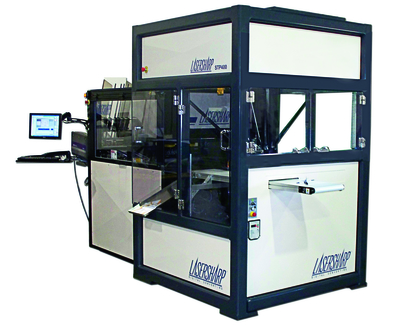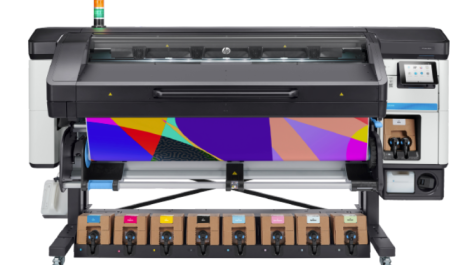This is a Lasersharp STS with 400W laser cutter, fitted with a vacuum transport belt unit and stacker. It can run with a sheet or roll feeder, or be integrated inline with a press, creaser and folder-gluer
Laser cutters offer exciting and unique capabilities and can now keep up with digital presses. Simon Eccles looks at LasX, the latest range to reach the UK.
By now everyone who is anyone in print knows that digital presses can produce personalised and short run work. Rather less familiar is the concept of personalised finishing, yet potentially it is just as significant for both design and production of printed work.
The past couple of years have seen the arrival of laser cutters with speeds and formats that can keep up with digital presses and sometimes even run inline with them. The big advantage of laser cutting is that you do not have the expense and waiting time associated with creating metal dies. Modern high-powered lasers do not leave scorch marks unless they have to slow down for especially tough/thick substrates.
At drupa 2012 we saw the advent of the Highcon Euclid, a big £582,000 B1 sheet-fed carton finisher that mixes three powerful cutting lasers with a clever but non-variable polymer rule extruder for creases. Last year marked the arrival of the laser motioncutter from themediahouse in Germany.
This is a smaller format laser-only machine (for widths of 580 mm and unlimited lengths), costing around £164,000. Speed depends on the cut-line lengths, but is quoted as 1500 to 3000 B2 sheets per hour.
Ipex marked the European debut of the US built LasX Industries LaserSharp STS range into the print market. These are being distributed by German company Pro Cut. Steve Giddins at Perfect Bindery Solutions is a UK agent and he had giveaway samples and a video of the LasX systems on his Ipex stand: N3-D255. Dirk Stünkel, the owner of Pro Cut, was also be present at Ipex.
The Lasersharp STS cutter competes more with the motioncutter than the Euclid, as it has similar format, configuration and price structure. Its width is 600 mm and length is unlimited, so B2 sheets can easily be handled. Robotic stackers can be fitted to sort cut items into piles of the same type.
Starting price is about £180,000 for a 400W laser system, but a higher power 1000W laser is available for higher speeds or tougher materials.
Apart from paper, the cutter can handle acrylics as well as industrial materials such as flexible circuit boards and abrasive papers. The price includes workflow software that can pre-flight the job and fix problems such as unclosed contours, as well as workingalongside print workflows.
Options include a barcode reader for onthe- fly pattern call-up, also helping to ensure data integrity (ie the cut matches the job it is supposed to match). A knife creaser can also be fitted upstream of the laser unit. Registration to the print can be aided by single or twin cameras. For carton conversion work, LasX can fit folder-gluers from either Brandtjen & Kluge or Petratto, inline with the cutting unit.
Mr Stünkel says that in principle wider machines are possible, though he is not convinced there will be a demand. ‘We are aware that digital printers are attempting to get as wide as traditional printers, but we do not think the really wide printers will lend themselves to short orders,’ he said. ‘We can place multiple lasers across the width to cover areas up to 500 mm, or two lasers of 350 mm would cover 700 mm and can work simultaneously.’
Laser scoring is also possible with the STS machine. This takes a channel out of the cartonboard material, so it folds easily. Unlike a knife-formed and moulded crease, scoring weakens the material, but for some types of carton this will not matter or is insignificant.
The internal media transport is a vacuum belt and it can run either as a standalone with a pile feeder for sheets, a roll feeder, or inline with a digital press – this has already been done with HP Indigo and Xerox iGen4 machines. Xerox offers the LasX cutter and stacker as an inline option as part of its Robotic Print Solution in the USA.
While laser cutting can be used for carton work, the same process also works well for paper and other thin card, opening up all sorts of possibilities with greetings cards, book covers and general paper engineering work.
The highly controllable lasers can create very detailed ‘filigree’ patterns that are hard to do even with die stamps, because of the issue of removing waste. The laser simply vaporises waste in finely detailed areas.
You could also use the laser to perforate, including unique security patterns that are very hard to counterfeit. If you wind the laser power down, it can be used to burn off printed ink in some areas, so you can get personalised results even from a non-variable print job.





